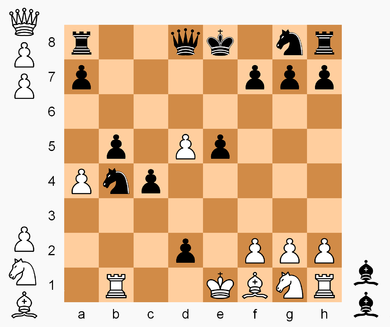
- Chess World Cup
- FIDE Grand Prix
- Olympiad
- World Championship
- List of strong tournaments
- List of world championships

- Checkmate patterns
- Chess openings
- Chess strategy
- Chess tactics
- Chess theory
- Endgames
- Pawn structure
- Problems/Compositions












 In the Fried Liver Attack (1.e4 e5 2.Nf3 Nc6 3.Bc4 Nf6 4.Ng5 d5 5.exd5 Nxd5 6.Nxf7 Kxf7 7.Qf3+ Ke6; see diagram), Black is okay in standard chess, but in Hostage Chess the line fails: White wins a knight with 8. Bxd5+, since if Black recaptures 8... Qxd5, White plays the hostage exchange 9. (N-B)*f7+ (transferring the black knight in his prison to Black's airfield, then releasing the white bishop from Black's prison and dropping it on f7 with check) to win Black's queen.
In the Fried Liver Attack (1.e4 e5 2.Nf3 Nc6 3.Bc4 Nf6 4.Ng5 d5 5.exd5 Nxd5 6.Nxf7 Kxf7 7.Qf3+ Ke6; see diagram), Black is okay in standard chess, but in Hostage Chess the line fails: White wins a knight with 8. Bxd5+, since if Black recaptures 8... Qxd5, White plays the hostage exchange 9. (N-B)*f7+ (transferring the black knight in his prison to Black's airfield, then releasing the white bishop from Black's prison and dropping it on f7 with check) to win Black's queen.Hostage Chess is a chess variant invented by John Leslie in 1997. Captured pieces are not eliminated from the game but can reenter active play through drops, similar to shogi. Unlike shogi, the piece a player may drop is one of his own pieces previously captured by the opponent. In exchange, the player returns a previously captured enemy piece which the opponent may drop on a future turn. This is the characteristic feature of the game.
Hostage Chess has tactical subtlety and "tends to favour the attacker". It was published in magazines Nost-algia (issue 375), Eteroscacco (86-88), and Variant Chess (32 and later). It was the "Recognized Variant of the Month" in January 2005 at The Chess Variant Pages.
Hostage Chess follows all the standard rules of chess with the exception of how captured men are treated. Each player owns reserved spaces off the chessboard: a prison to the player's right, and an airfield to the player's left. Captured men are not removed from the game but are held in the capturer's prison. Instead of making a normal move, a player can execute a hostage exchange to "rescue" one of his men held prisoner by the opponent and drop the freed man back into play on the board on an open square. The man exchanged for the dropped man is transferred from the player's prison to the opponent's airfield. On any turn, instead of making a normal move, a player can drop a man from his airfield into active play on the board.
A hostage exchange is executed by transferring a man from one's prison to the opponent's airfield, then selecting and releasing a man from the opponent's prison and immediately dropping it on an empty square on the board. The drop completes the turn. The man transferred must be of equal or greater value than the man released from prison and dropped. The relative piece values are: Q > R > B = N > P. (So, any man can be exchanged to free a pawn; whereas only a queen can be exchanged to free a queen.) A hostage exchange cannot be refused by the opponent.
A drop can occur as part of a hostage exchange, or directly from a player's airfield.
A pawn can promote only to an available Q, R, B, or N in the opponent's prison. The promoting player selects which piece to release and promote to; the pawn is transferred to the opponent's prison. If the promoted piece is subsequently captured, it retains its type when entering prison.
So, in the case of a pawn on a player's 7th rank with no available piece to promote to, the pawn cannot advance. Additionally, if the opponent's king is diagonally in front of the pawn:
Standard chess notation is used with some extensions. A drop is indicated by symbol *. For a hostage exchange, parentheses contain the man exchanged followed by the man freed from prison and dropped. For example, (B-N)*c7 means a bishop was exchanged to free a knight, and the knight was dropped on c7. Pawns are notated as P in hostage exchanges, for example: (P-P)*g5. The move N*c7 means a knight was dropped on c7 from the player's airfield. The move *g5 means a pawn was dropped on g5 from the player's airfield.
 Position after 19... (P-P)*d2+
Position after 19... (P-P)*d2+